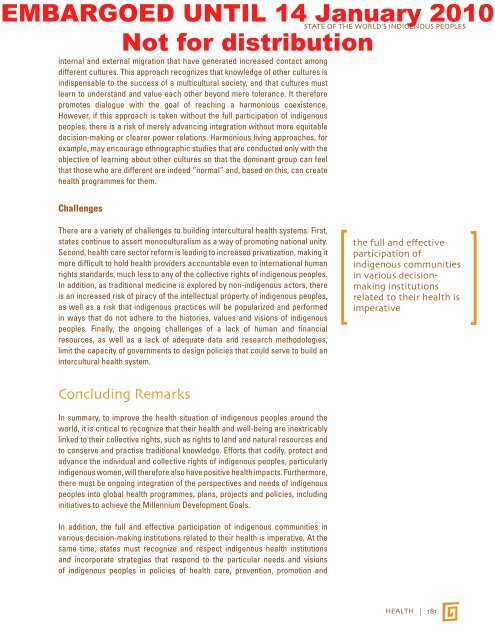STATE OF THE WORLD's INDIGENOUs PEOpLEs - CINU
STATE OF THE WORLD's INDIGENOUs PEOpLEs - CINU
STATE OF THE WORLD's INDIGENOUs PEOpLEs - CINU
- No tags were found...
You also want an ePaper? Increase the reach of your titles
YUMPU automatically turns print PDFs into web optimized ePapers that Google loves.
EMBARGOED UNTIL 14 January 2010<strong>STATE</strong> <strong>OF</strong> <strong>THE</strong> WORLD’S INDIGENOUS PEOPLESNot for distributioninternal and external migration that have generated increased contact amongdifferent cultures. This approach recognizes that knowledge of other cultures isindispensable to the success of a multicultural society, and that cultures mustlearn to understand and value each other beyond mere tolerance. It thereforepromotes dialogue with the goal of reaching a harmonious coexistence.However, if this approach is taken without the full participation of indigenouspeoples, there is a risk of merely advancing integration without more equitabledecision-making or clearer power relations. Harmonious living approaches, forexample, may encourage ethnographic studies that are conducted only with theobjective of learning about other cultures so that the dominant group can feelthat those who are different are indeed “normal” and, based on this, can createhealth programmes for them.ChallengesThere are a variety of challenges to building intercultural health systems. First,states continue to assert monoculturalism as a way of promoting national unity.Second, health care sector reform is leading to increased privatization, making itmore difficult to hold health providers accountable even to international humanrights standards, much less to any of the collective rights of indigenous peoples.In addition, as traditional medicine is explored by non-indigenous actors, thereis an increased risk of piracy of the intellectual property of indigenous peoples,as well as a risk that indigenous practices will be popularized and performedin ways that do not adhere to the histories, values and visions of indigenouspeoples. Finally, the ongoing challenges of a lack of human and financialresources, as well as a lack of adequate data and research methodologies,limit the capacity of governments to design policies that could serve to build anintercultural health system.the full and effectiveparticipation ofindigenous communitiesin various decisionmakinginstitutionsrelated to their health isimperativeConcluding RemarksIn summary, to improve the health situation of indigenous peoples around theworld, it is critical to recognize that their health and well-being are inextricablylinked to their collective rights, such as rights to land and natural resources andto conserve and practise traditional knowledge. Efforts that codify, protect andadvance the individual and collective rights of indigenous peoples, particularlyindigenous women, will therefore also have positive health impacts. Furthermore,there must be ongoing integration of the perspectives and needs of indigenouspeoples into global health programmes, plans, projects and policies, includinginitiatives to achieve the Millennium Development Goals.In addition, the full and effective participation of indigenous communities invarious decision-making institutions related to their health is imperative. At thesame time, states must recognize and respect indigenous health institutionsand incorporate strategies that respond to the particular needs and visionsof indigenous peoples in policies of health care, prevention, promotion andHEALTH | 181
















